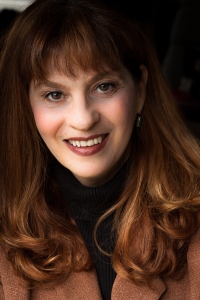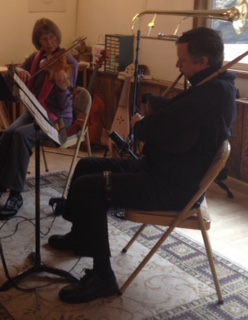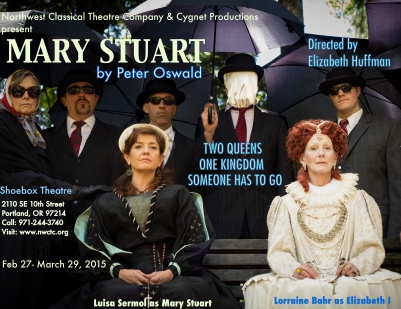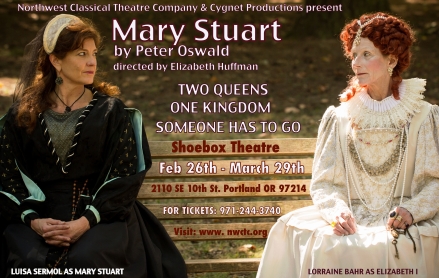Directing Mary Stuart: A thrilling balancing act
I owe nearly everyone favors after this one!
Bringing Mary Stuart to production has been over a two-year journey, starting with a desire to direct a project with Luisa Sermol whose work I adore. We found that we both shared a love for this play and, for Luisa in particular, a burning desire to bring this iconic queen and her powerful story to life. Mary Stuart has been a deep part of her Scottish upbringing and her lifelong dream to play her is finally at hand.
Then Louanne Moldovan, my dear friend & Artistic Director of Cygnet Productions and I teamed up and decided we can do this. With her at the producing helm we prepared our case for CoHo to be considered for their selection a few years ago.
Disappointingly we were not selected but damn, this project, somewhat like Mary Stuart, refused to give up!
Grant Turner stepped in and offered to make the project a part of his season and we were so grateful and delighted. At the time Val Stevens was on board to play Elizabeth but when she moved to Los Angeles, we cast about for the right actress to play Mary’s nemesis. We saw so many wonderful actresses for it but it was Lorraine Bahr who completely embodied that legendary queen, as if she was to the manor born. So with our queens in place, soon the rest of the cast came on board with every actor bringing their talent and serious A game to the table; in one case coming all the way from London to throw his lot in with us: my friend and former LA company member, British actor Philip Whiteman.
Knowing that it would cost more than NWCTC usually can afford, we threw a fundraising party and collected some extra bucks with the help of many friends, and so off we went to find the creative team.
No director works alone.
If you are lucky, you get to assemble a team of artists whose specific knowledge and skill opens doors to the most creative ways possible for you to tell your story, often straining themselves and their resources to do so within your budget. Because they are rock stars somehow finding ways of solving limitations by pretending that they do not exist, they have all created aspects of this show that I never dreamt we could have, just so that I could realize my vision of this play. They all are my heroes; each one adding their care and artistry so what you will see is a true collaborative effort of many talented people, all working to make me look much cleverer than I really am! So I want you to know who they are:
With a smart set design by Megan Wilkerson and the technical building skills of my friend and fellow actor Jeff Arrington, they helped me to turn the intimate Shoebox into a perfectly elegant jewel box that amply allows me to travel back and forth from Whitehall to Fotheringay prison. I am blown away, as always, by the truly stunning sound design by the brilliant Sharath Patel and the haunting score created by him and Gayle and Philip Neuman. I am honored again by the care and beauty of the sculpted lighting design created in such a tiny space by my gentle and talented friend Brian Guerrero. What the actors are wearing is the result of lots of research, considered choices and many hours of hard work by Rusty Twelerp and Chloe Golberg to create the “drop my jaw in awe” costumes created.
I am delighted to have met and worked with Janet Trygstadt who taught us beautiful period dance moves as well as my favorite fighting goddess, Kristen Mun who I also just like to have around because she is SO badass! . Then Andrés Alcalá, a brilliant actor in his own right, waltzes in with his magic computer & mind boggling editing skills to create beautifully lush images that I still can’t believe I have for this show.
Finally our intrepid Stage Manager, who I now believe I cannot live without, the sweet but determined Jenn Lindell who is somehow going to run the whole shebang all by herself.
So you see I am a lucky director. This has been and is about to be an epic journey for all of us. We are primed and excited to share it with you.
As for my favorite lines here are a few that sum up this powerful play for me:
Men love to see the sword of justice grasped by a man, but they can’t stand it being wielded by a woman- Lord Burleigh
Odd that a queen has no more advantages than an ordinary kind of woman- Queen Elizabeth
Do not forget that nothing stands forever. That there are gods who punish pride- the proof is at your feet- Mary Stuart
Song that best sums it up for me: “What’s love got to do with it?”
Thanks for letting me ramble and hope to see you there or around town afterwards!
-Elizabeth Huffman, Director of Mary Stuart





Recent Comments